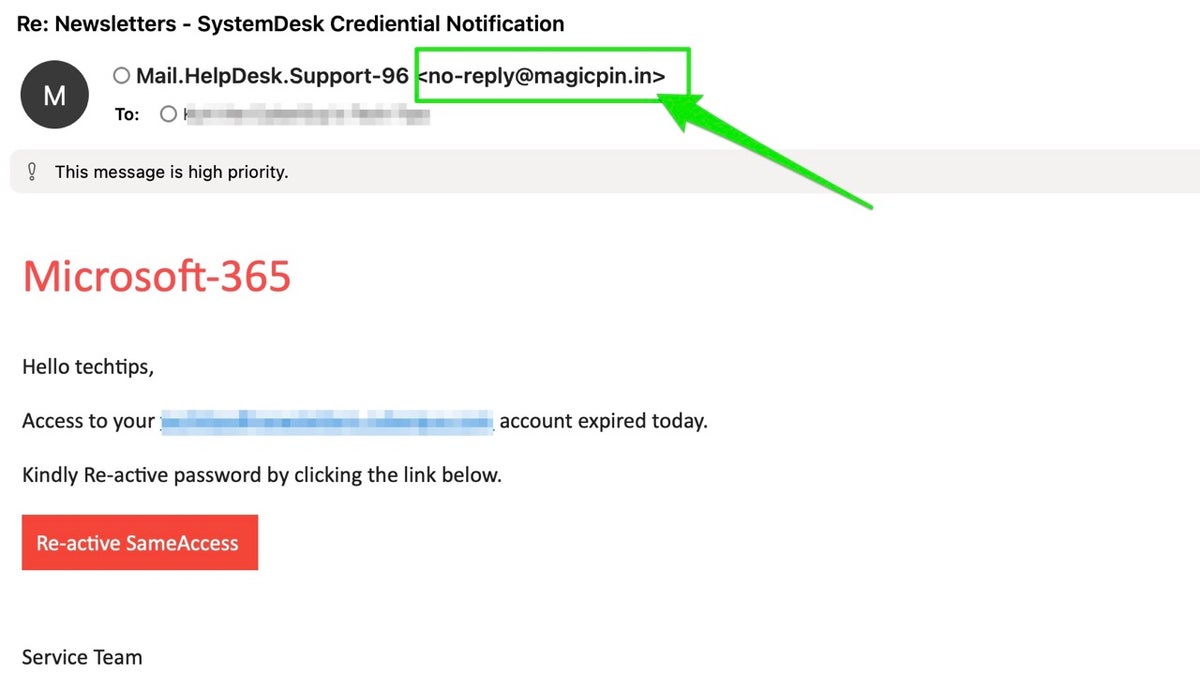The massive budget bill signed into law by President Donald Trump on Independence Day didn’t include everything on Big Tech’s wishlist, but the industry’s largest players stand to gain significantly from several provisions in the One Big Beautiful Bill Act.
Technology
Your email didn’t expire; it’s just another sneaky scam

It’s hard to ignore the rise of phishing scams these days. They seem to pop up in our inboxes with alarming frequency. As we become more aware of these deceptive tactics, scammers are also upping their game, using increasingly sophisticated methods to lure in unsuspecting victims.
One particularly sneaky tactic involves impersonating a help desk or support team. You might receive an email claiming that your Microsoft 365 account is set to expire today.
The goal? To create a sense of panic and urgency, prompting you to act quickly without thinking. So, how do you recognize these scams and protect yourself from falling victim to them? Let’s go down that road to keep you safe.
I’M GIVING AWAY A $500 GIFT CARD FOR THE HOLIDAYS
A woman opening email on laptop (Kurt “CyberGuy” Knutsson)
How can you tell if it is a scam email?
It’s easy to see why people fall prey to these sorts of tactics, because scammers do a relatively good job of making these scam emails appear professional and legitimate. They go as far as to change the contact information of the email sender to something legitimate like an actual helpdesk or IT department or business.
Upon further examination of the email sender’s contact information, you can see that the domain address of the actual email address is different and random. For example, the name in the “From” field of the email may read from helpdesk, but if you click on the contact information to view the email address, it will have a domain from @magicpin.in, @gmail.com or @hotmail.com, etc. If it’s an email supposedly from Microsoft, you’d expect the domain to be microsoft.com.

Microsoft scam email (Kurt “CyberGuy” Knutsson)
DON’T CLICK THAT LINK! HOW TO SPOT AND PREVENT PHISHING ATTACKS IN YOUR INBOX
How are victims exploited by these types of scams?
Getting a “fake” email may seem relatively benign, but it can be a slippery slope to identity theft and fraud. Below are ways in which scammers take advantage of their victims with these phishing email scams:
1. Email validation: By opening the email or engaging with the email (clicking a link or responding to it), you can validate that the email account they messaged is active. Oftentimes, scammers randomly email people whose email address they’ve gotten from data breaches, the dark web or data harvesting.
2. Information gathering: If you reply to the email or use any other contact information they provide to “reinstate” your account, it will validate that the email address they reached out to is active, and they will likely hard-sell you for financial and personal information. If you call any phone number they provide you, they will also connect your phone number with your email address so they can continue to update their information on you.
3. Malware distribution: They will often have buttons, links or attachments included in the email. If you click the attachment, it can download malware or a virus to your device. If you click on a link that’s provided in the email, it might take you to a website that will collect your personal and financial information or download malware or viruses to your device.
CLICK HERE FOR MORE US NEWS

Illustration of scammer at work
SNEAKY SCAMMERS DRAIN BANK ACCOUNT IN SINISTER PHONE PHISHING SCHEME
What should you do if you receive these types of phishing emails?
There are a few easy steps you can take if you receive an email you suspect is a phishing scam.
1. Do not click on any links or buttons and do not download or open any attachments: This helps prevent malware installation and protects your personal information. The best way to safeguard yourself from malicious links that install malware, potentially accessing your private information, is to have antivirus software installed on all your devices. This protection can also alert you to phishing emails and ransomware scams, keeping your personal information and digital assets safe. Get my picks for the best 2024 antivirus protection winners for your Windows, Mac, Android and iOS devices.
2. Do not reply or reach out to these scammers by email or phone: Engaging with them can confirm your email address is active, leading to more scams.
3. If your email client allows it, you can block the sender and report it as a phishing email: This action helps protect yourself and others by alerting your email provider to malicious activity.
4. Verify the email’s legitimacy by checking the official website of the organization: Directly accessing your account ensures you receive accurate information without falling for fake notifications.
5. If two-factor authentication is offered for your account, enable it: 2FA adds an extra layer of security, making it harder for scammers to gain access even if they have your password.
6. Invest in personal data removal services: Reducing your digital footprint minimizes the risk of identity theft and scams based on harvested data. While no service promises to remove all your data from the internet, having a removal service is great if you want to constantly monitor and automate the process of removing your information from hundreds of sites continuously over a longer period of time. Check out my top picks for data removal services here.
HOW TO STOP PROMOTIONAL EMAILS WHERE YOU CAN’T UNSUBSCRIBE
Kurt’s key takeaways
Phishing scams are becoming increasingly sophisticated, but staying informed and vigilant can significantly reduce your risk. By adopting good digital habits and following the tips we’ve shared, you can navigate the online world with confidence. Remember, awareness is your best defense, so keep sharing this knowledge with friends and family to help protect everyone from these deceptive tactics.
What’s the most unusual or clever phishing attempt you’ve encountered, and how did you recognize it as a scam? Let us know by writing us at Cyberguy.com/Contact.
For more of my tech tips and security alerts, subscribe to my free CyberGuy Report Newsletter by heading to Cyberguy.com/Newsletter.
Ask Kurt a question or let us know what stories you’d like us to cover.
Follow Kurt on his social channels:
Answers to the most asked CyberGuy questions:
New from Kurt:
Copyright 2024 CyberGuy.com. All rights reserved.

Technology
What Big Tech got out of Trump’s Big Beautiful Bill

The Republican-backed legislation is best known for its tax cuts on tips, deduction caps that could primarily benefit wealthy taxpayers, restriction on healthcare coverage for low-income and disabled Americans, cuts to renewable energy incentives, and tens of billions of dollars in funding to immigration enforcement. But it also includes restored tax deductions for research and development and other items that could benefit the tech industry, among other businesses.
In one high-profile fight, the tech industry failed to secure a moratorium on state AI laws, a proposal which had been supported by several trade groups and might have also affected a host of other state tech protections. But after months of lobbying from Congress to Mar-a-Lago, the industry will see slashed taxes and may receive new contracts from border enforcement funding, the Tech Oversight Project finds in a new report shared exclusively with The Verge. Some changes will likely benefit businesses of all sizes and sectors — while others may offer large companies in the tech industry the biggest benefits.
The budget bill essentially reverses a policy from Trump’s first term that limited how companies could write off research and development on their taxes. The 2017 Tax Cuts and Jobs Act (TCJA) forced companies to spread write-offs for domestic R&D costs across five years, rather than deducting them fully in the year they were incurred. Now, Congress is restoring the previous, more generous deduction setup, and small businesses can get retroactive tax write-offs for the last couple years when the changes — which took effect in 2022 — were in place.
In a recent report, Quartz linked the R&D deduction changes to the wave of layoffs across the industry, describing how it made it so companies could effectively only write off one-fifth of their R&D costs in the year they were incurred, rather than the full sum, making salaries for engineers and other high-skilled roles much more costly. The nonpartisan Institute on Taxation and Economic Policy (ITEP) found that in the three years in which the TCJA changes took effect, Alphabet, Amazon, Apple, Meta, and Tesla saw their tax bills rise a collective $75 billion as a result.
“The loss of full R&D expensing disincentivizes firms from significantly increasing their R&D investments”
So unsurprisingly, tech-backed groups like the Information Technology and Innovation Foundation (ITIF) and the Business Software Alliance (BSA) pushed to revert the rule. “The loss of full R&D expensing disincentivizes firms from significantly increasing their R&D investments because the cost of those investments has risen,” ITIF wrote in a blog post earlier this year.
Maintaining a lower corporate tax rate
Conversely, business groups successfully pleaded with lawmakers to keep a different change from the TCJA: a massive reduction in the corporate tax rate from 35 percent to 21 percent. In a letter to lawmakers last year, tech-backed Information Technology Industry Council (ITI) told lawmakers that the reduction had brought the US in line with peer countries, and provided US companies “a more level playing field against their international competitors,” which the nonprofit Tax Foundation found helped boost US investment. Democrats who have opposed the lower tax rates have framed it as a handout to corporate America.
Extending lower international tax rates
The new budget law also blocks a scheduled increase in the effective tax rates on things like the money companies make abroad based on US-based patents or other intangible assets.
These kinds of taxes — the base erosion and anti-abuse tax (BEAT), global intangible low-taxed income tax (GILTI), and the foreign-derived intangible income tax (FDII) — are generally meant to prevent shifty accounting practices like moving assets to a foreign subsidiary. Before the One Big Beautiful Bill Act passed, the effectively lowered rates through these three policies were set to expire at the end of 2025.
The tech industry argued protecting those low rates would keep US companies competitive with other countries, like France and the UK. “Several other nations already offer IP incentives,” ITI told lawmakers in an October letter. “It is essential that the FDII rate remains as low as possible.”
“The tax break disproportionately benefits large corporations with significant intellectual property portfolios”
But groups like the nonpartisan Financial Accountability and Corporate Transparency (FACT) Coalition and ITEP see lower rates for taxes like the FDII as a giveaway to the biggest players in the tech industry, which deal heavily in intangible assets like patents and trademarks.
“The tax break disproportionately benefits large corporations with significant intellectual property portfolios while doing little for smaller firms that lack similar assets,” ITEP wrote in a blog post last year, where it found that Google parent Alphabet reported over $11 billion in tax benefits from 2018 to 2023 as a result of the FDII.
Border protection funding could flow to tech
Alongside a significant budget increase for Customs and Border Protection (CBP) and other immigration-related funding, the law includes about $6 billion for border technologies, including surveillance systems. That money could flow to several large tech firms already engaged in the space.
Those include Peter Thiel-founded data company Palantir, which currently has a $30 million contract with Immigration and Customs Enforcement (ICE) to build “ImmigrationOS” to create “near real-time visibility into instances of self-deportation.” Thiel-backed Anduril also stands to gain if the agency expands infrastructure like the surveillance towers it already supplies to the government. MIT Technology Review reported in 2018 that Amazon Web Services hosted Department of Homeland Security (DHS) databases related to immigration, including a deep pool of biometric data.
Other tax-saving adjustments
Tech companies and other businesses will also benefit from changes in how business interest deductions are calculated, and a permanent extension of rules allowing companies to take a full deduction of certain equipment expenses. House Democrats have previously called this kind of tactic a “Tax Scam,” writing, “Two-thirds of the benefits go to corporations making over $250 million in revenue, and from 2018 through 2021, about two dozen of the largest corporations received roughly $50 billion in tax breaks through this provision.”
Some of the tax changes in the bill will benefit smaller firms and businesses across many different industries. But large tech companies are particularly well positioned to benefit from changes in how foreign profits on intellectual property are taxed and fuller R&D write-offs. After months of cozying up to the Trump administration with little to show for it, it looks like the largest players in the industry have finally notched some wins.
Technology
Spying camera vest deters attackers by recording them in action

NEWYou can now listen to Fox News articles!
When you’re out walking, jogging or running, you should feel empowered, not unsafe. Yet a recent survey found that 92% of women in the U.S. reported feeling concerned for their safety while running, with half of those women fearing physical attack.
Additionally, over one-third experienced physical or verbal harassment, including sexist comments, honking, or being followed. To help address this alarming trend, Urban Eyes introduces a high-visibility safety vest with cameras built in. By capturing real-time footage of your surroundings, this clever wearable tech empowers you to stay focused, feel protected, and reclaim control of your outdoor workouts.
Sign up for my FREE CyberGuy Report
Get my best tech tips, urgent security alerts, and exclusive deals delivered straight to your inbox. Plus, you’ll get instant access to my Ultimate Scam Survival Guide – free when you join my CYBERGUY.COM/NEWSLETTER.
ATM JUGGING SCAM ON THE RISE AS THIEVES TARGET VICTIMS
A man running while wearing a safety vest with cameras (Urban Eyes)
How a safety vest with cameras helps deter attackers
Attackers don’t want to be caught on camera. When you wear a vest with front and rear cameras, you send a clear message: you’re being recorded. This visible deterrent makes would-be harassers think twice before approaching. With bright white, eye-shaped cameras and flashing blue LEDs, Urban Eyes makes sure everyone knows you’re protected.

A woman wearing a safety vest with cameras (Urban Eyes)
How this safety vest with cameras works in action
Slip on the vest, power up the cameras, and hit the ground walking, jogging or running. The wireless remote lets you control both cameras with one button. Want to snap a photo? Just press the remote. All footage is stored locally, so you’re always in control, no cloud connection required.
WHAT IS ARTIFICIAL INTELLIGENCE (AI)?
Top features of this safety vest with cameras
- Dual 2.5K cameras: Capture every stride, front and back, day or night.
- Ultra-lightweight design: Weighs just 0.9 lb, moves freely without feeling weighed down.
- High-visibility panels: Reflective piping and bold colors keep you seen in low light.
- Long battery life: Record up to 90 minutes on a single charge.
- Secure storage: Footage saves directly to SD cards in each camera.
- Easy Plug & play: No app headaches. Use the wireless remote to start, stop, or pause recording instantly.

Pocket-sized remote for the safety vest with cameras (Urban Eyes)
A safety vest designed for comfort and everyday use
Urban Eyes fits most chest sizes (28″-52″) and comes in five color combos. The adjustable waistband and breathable fabric mean you can sprint, jog, or walk comfortably. There’s a large zippered pocket for your phone and smaller pockets for keys or cards, no more juggling essentials.
The benefits of this safety vest with cameras
The Urban Eyes safety vest with cameras gives walkers, runners or joggers, a sense of control and confidence. Knowing the cameras are recording adds an extra layer of protection, making it easier to stay focused instead of feeling vulnerable. The vest’s bright colors and reflective details make sure you’re seen by drivers and cyclists, even in dim conditions. It also keeps things simple. There’s no need to download an app or connect to Wi-Fi. You just press the remote and start recording. Most importantly, it gives you peace of mind. Instead of worrying about who might be behind you, you can concentrate on your pace and your path, knowing that your vest is capturing everything along the way.

A woman holding the pocket-sized remote while wearing a safety vest with cameras (Urban Eyes)
Urban Eyes safety vest: Price and preorder info
Urban Eyes is available for preorder at about $204. Choose your color, order online, and expect delivery in about 35 days.
Kurt’s key takeaways
Personal safety tech has come a long way.
With Urban Eyes, you get more than a vest; you get a visible deterrent and a personal eyewitness. You protect your home, car, and personal data; why not protect yourself when you’re out and about?
Would you feel safer running, walking, or jogging with a camera vest, or do you prefer other safety gadgets? Let us know by writing us at Cyberguy.com/Contact.
Sign up for my FREE CyberGuy Report
Get my best tech tips, urgent security alerts, and exclusive deals delivered straight to your inbox. Plus, you’ll get instant access to my Ultimate Scam Survival Guide – free when you join my CYBERGUY.COM/NEWSLETTER.
Copyright 2025 CyberGuy.com. All rights reserved.
Technology
Stranger Things 5’s first trailer promises an epic showdown

It’s been a long time coming, but we finally have a real look at the end of Stranger Things. Netflix just released the first teaser trailer for the show’s fifth season, which will also be its last when it starts streaming later this year. As was alluded to in the finale of season 4, the new trailer — which, despite being called a teaser, clocks in at nearly three minutes long — is focused on the major showdown with Vecna that will presumably end the string of supernatural bad luck in Hawkins, Indiana for good.
Here’s the official setup for the finale, according to Netflix:
The fall of 1987. Hawkins is scarred by the opening of the Rifts, and our heroes are united by a single goal: find and kill Vecna. But he has vanished — his whereabouts and plans unknown. Complicating their mission, the government has placed the town under military quarantine and intensified its hunt for Eleven, forcing her back into hiding. As the anniversary of Will’s disappearance approaches, so does a heavy, familiar dread. The final battle is looming — and with it, a darkness more powerful and more deadly than anything they’ve faced before. To end this nightmare, they’ll need everyone — the full party — standing together, one last time.
-

 News1 week ago
News1 week agoVideo: Trump Compliments President of Liberia on His ‘Beautiful English’
-

 News6 days ago
News6 days agoVideo: Clashes After Immigration Raid at California Cannabis Farm
-

 Politics1 week ago
Politics1 week agoJournalist who refused to duck during Trump assassination attempt reflects on Butler rally in new book
-
Business1 week ago
Commentary: Does America need billionaires? Billionaires say 'Yes!'
-

 Politics1 week ago
Politics1 week agoObama officials used dossier to probe, brief Trump despite knowing it was unverified 'internet rumor'
-

 News1 week ago
News1 week agoDOGE keeps gaining access to sensitive data. Now, it can cut off billions to farmers
-

 World6 days ago
World6 days agoNew amnesty law for human rights abuses in Peru prompts fury, action
-

 News6 days ago
News6 days agoTrump heads to Texas as recovery efforts from deadly flood continue
















